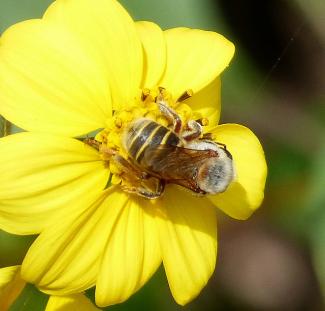
Image Credit: gailhampshire
Stingless Bees: (Apidae: subfamily Meliponinae; Melipona, Trigona (and many related genera)) Not native to the PNW
These are truly social bees like the honeybee. They are generally small- to mid-sized bees with colonies from several dozen to several hundred individuals; exceptional species have colony sizes as great as honeybees. They are found through the tropical regions of the world. Endemic societies of in many tropical regions utilize their honey. They all have lost the ability to sting. This group includes a number of species of Trigona that cuckoo-parasitize their close social relatives. In most tropical countries, particularly in forested regions, they greatly outnumber all other bee species combined. They share the possession of a corbiculum (“pollen-basket”) on the hind leg with both bumblebees and honeybees. Some species are known to co-habit in sealed off sections of ant and termite nests.


Melipona are generally mid-sized bees that are often mistaken for Apis in the field. They often have very large colony populations.




Trigona seem to be infinitely variable in the tropics of the world. Many colors, sizes and shapes, but always “dainty”. Their hind legs (with a corbicula) are kept extended while in flight in a very characteristic pose. Nests can be rather small, like the one on the (left) wall or very populous like the entrance tunnel (on the right).